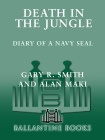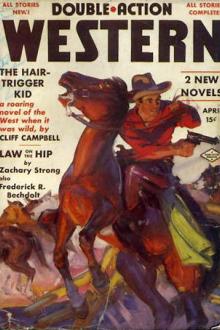Death in the Jungle by Gary Smith (most inspirational books .txt) 📕

Read free book «Death in the Jungle by Gary Smith (most inspirational books .txt) 📕» - read online or download for free at americanlibrarybooks.com
- Author: Gary Smith
Read book online «Death in the Jungle by Gary Smith (most inspirational books .txt) 📕». Author - Gary Smith
As I joined the two six-man squads from SEAL Team 1 and fourteen-man SEAL Team 2 platoon on the ship’s flight deck for a mission briefing at 1200 hours, led by Lt. (jg) Demo Dick Marcinko, I reflected for a minute on the past several days and our previous four missions on Dung Island. We’d blown up a VC blockade that had been built across a river to stop PBRs from passing through; we’d fired at sampans and junks on a pitch-black night and hit who-knows-what; and MM1 Martin and I had killed two VC in a sampan as it had drawn to within fifteen feet of us. I also thought about the somber fact that four SEALs had been killed in Vietnam in just the previous fifteen days; actually, all had been killed in an eleven-day period. SN Roy Keith had been killed on January 11 by small arms fire at Ba Xuyen. GMG1 Arthur Williams had been killed in the Mekong on January 18 by small arms fire. LCDR Robert Condon of UDT-12 had been killed instantly in a Mekong River ambush when a VC B-40 rocket had hit him in the head. ADR2 Eugene Fraley had died on January 21 at My Tho when a booby trap he was setting had accidentally detonated. Death had struck down four good men in a hurry. I wondered who would be next, aware that it could easily be me.
I turned my attention to Mr. Marcinko as he ran us through the details of the day’s operation. He told us we were going to patrol along a canal into an area populated by many Vietnamese families living in their hootches. Our intelligence people reported that somewhere in the locality was a POW camp where a U.S. Army sergeant had been held since 1961. We were to search for the camp and the American soldier. That information got my adrenaline flowing, as it was the kind of mission every SEAL dreamed about: rescuing a fellow warrior from the enemy. The risk involved was higher than usual due to the fact that our squads would be visible and exposed as we would investigate all of the hootches in broad daylight.
When the briefing concluded, the two squads under Mr. Van Heertum’s command and the SEAL 2 platoon, led by Mr. Marcinko, boarded five PBRs and headed down the Bassac River toward Dung Island. Two Boston Whalers with 125-horsepower Mercury outboard engines and an LCPL-MK4 traveled with us. With this mission recognized as a particularly dangerous one, we were not lacking in support.
After a short ride, the boats journeyed around the western side of Dung Island on the Song Hau Giang. Six miles down the river, we turned east on the Khem Lon, which swung southeast after one thousand meters. A trip covering two klicks brought us to the mouth of a small stream called the Rach Gia, which was our insertion point. Mr. Marcinko’s platoon inserted on the left bank of the waterway, while Mr. Van Heertum’s twelve men were dropped on the right bank.
With the water between us, the two groups of men began advancing upstream in skirmish lines. I was positioned on the right flank with Martin and DiCroce, two teammates who had served with me at Nha Be. Bad Girl was in my hands, with her double barrels pointed ahead, ready for action.
I was instantly awestruck by the beauty of the jungle as we moved forward, as that was the first time I’d been on Dung Island in the daytime. There were coconut palm trees everywhere, and there were irrigation canals crisscrossing in front of us every ten yards. The canals were six-foot-deep ditches, about fifteen feet wide and flowing with water that was two feet deep. At each canal, we staggered our skirmish line so that only a couple of men dropped in and out of the ditch at a time. This was done for security purposes.
Between the canals I found a dozen spider traps, holes measuring four and a half feet deep and twenty inches in diameter, covered by a camouflaged, thatched lid. Enemy soldiers could hide in the spider traps, waiting for us to walk past before popping open the roofing and shooting at our backs. Those traps gave me the creeps, and my finger felt the M-16 safety to make sure it was on safe.
As I climbed out of the third canal with my eyes peeled, I saw several hootches in the trees just ahead on the opposite side of the canal. Then my ears picked up the laughter of children. When the rest of my squad came up beside me, I signaled them concerning the village.
Mr. Van Heertum moved us to the next canal, which we crossed quickly. We patrolled through a flock of domestic chickens, and as we entered the settlement, four Vietnamese children stood and stared at us from beside the nearest hootch. They appeared to be four to seven years old and quite obviously poor, though they were relatively healthy looking. Their faces, though, expressed sheer terror, and I thought the kids were too scared to move. I didn’t blame them in the least, for the twelve of us looked like a child’s worst nightmare come to life.
While the others faced the hootch in the skirmish line, DiCroce and I checked around the outside perimeter of the thatched hut. Finding nothing in back but a wandering pig, we returned to the front and entered the dwelling. My eyes adjusted to the dimmer light and I saw two old women cowering in a corner.
“Toi xem choi,” I said to them, assuring them that we were just looking around. DiCroce pointed at a small bunker built out of logs and mud in the opposite corner of the hootch. We checked it





Comments (0)